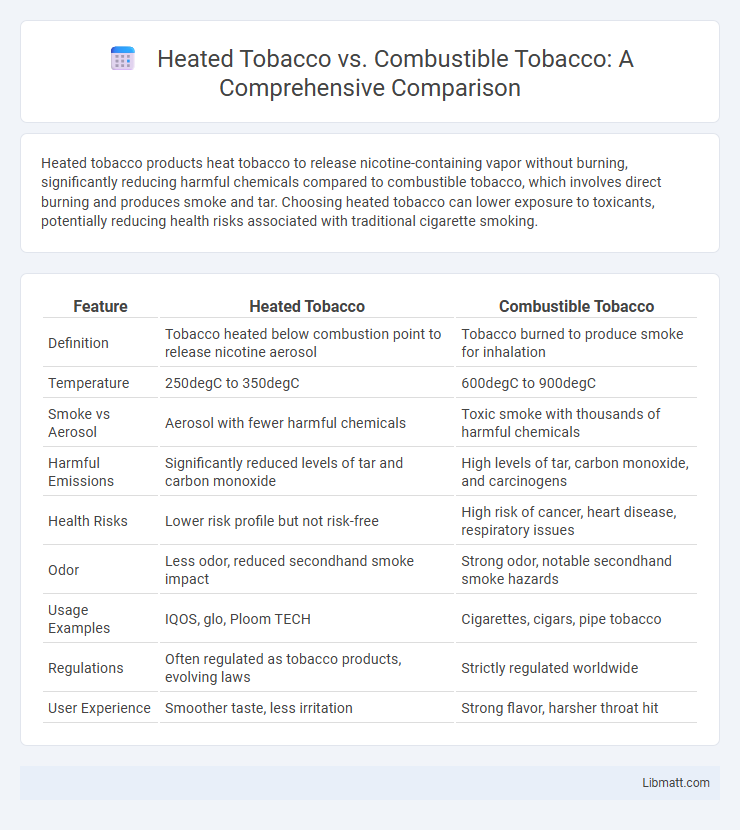Heated tobacco products heat tobacco to release nicotine-containing vapor without burning, significantly reducing harmful chemicals compared to combustible tobacco, which involves direct burning and produces smoke and tar. Choosing heated tobacco can lower exposure to toxicants, potentially reducing health risks associated with traditional cigarette smoking.
Table of Comparison
| Feature | Heated Tobacco | Combustible Tobacco |
|---|---|---|
| Definition | Tobacco heated below combustion point to release nicotine aerosol | Tobacco burned to produce smoke for inhalation |
| Temperature | 250degC to 350degC | 600degC to 900degC |
| Smoke vs Aerosol | Aerosol with fewer harmful chemicals | Toxic smoke with thousands of harmful chemicals |
| Harmful Emissions | Significantly reduced levels of tar and carbon monoxide | High levels of tar, carbon monoxide, and carcinogens |
| Health Risks | Lower risk profile but not risk-free | High risk of cancer, heart disease, respiratory issues |
| Odor | Less odor, reduced secondhand smoke impact | Strong odor, notable secondhand smoke hazards |
| Usage Examples | IQOS, glo, Ploom TECH | Cigarettes, cigars, pipe tobacco |
| Regulations | Often regulated as tobacco products, evolving laws | Strictly regulated worldwide |
| User Experience | Smoother taste, less irritation | Strong flavor, harsher throat hit |
Introduction to Heated and Combustible Tobacco
Heated tobacco products warm tobacco to release nicotine-containing vapor without burning, significantly reducing harmful chemicals compared to combustible tobacco, which involves burning tobacco leaves to produce smoke. Combustible tobacco generates thousands of toxic compounds linked to respiratory and cardiovascular diseases, while heated tobacco aims to minimize exposure by avoiding combustion. Scientific studies show that heated tobacco emits fewer harmful substances, presenting a potentially lower-risk alternative to traditional smoking.
How Heated Tobacco Products Work
Heated tobacco products use controlled heating elements to warm tobacco to temperatures below 350degC, producing a nicotine-containing aerosol without combustion. This process significantly reduces the release of harmful chemicals typically generated by burning tobacco in traditional cigarettes. By avoiding combustion, heated tobacco products offer a potentially lower-risk alternative for adult smokers seeking to mitigate exposure to toxicants found in combustible tobacco smoke.
What Is Combustible Tobacco?
Combustible tobacco refers to traditional tobacco products that are burned to produce smoke, such as cigarettes, cigars, and pipe tobacco. When you smoke combustible tobacco, the combustion process releases harmful chemicals and tar that pose significant health risks. Unlike heated tobacco, which heats tobacco without burning, combustible tobacco generates higher levels of toxicants due to the combustion process.
Key Differences Between Heated and Combustible Tobacco
Heated tobacco products operate by warming tobacco to release nicotine-containing vapor without burning the leaf, resulting in significantly lower levels of harmful chemicals compared to combustible tobacco, which involves direct combustion and produces smoke. The absence of combustion in heated tobacco reduces tar, carbon monoxide, and carcinogen emissions, offering a potentially reduced-risk alternative to traditional cigarettes. While both deliver nicotine, heated tobacco typically produces less odor and less environmental impact due to reduced particulate matter and smoke emission.
Health Risks: Heated Tobacco vs Combustible Tobacco
Heated tobacco products expose users to fewer harmful chemicals compared to combustible tobacco, resulting in reduced levels of toxicants and carcinogens. While not risk-free, heated tobacco is generally associated with lower biomarker levels linked to cardiovascular and respiratory diseases. Your health risks may decrease by switching from traditional cigarettes to heated tobacco, but complete cessation remains the most effective option for minimizing harm.
Chemical Emissions and Exposure Comparison
Heated tobacco products produce significantly lower levels of harmful chemical emissions compared to combustible tobacco by heating rather than burning tobacco, reducing the release of toxicants like tar, carbon monoxide, and carcinogens. Studies show that users of heated tobacco are exposed to fewer harmful substances, which may decrease health risks associated with smoking. Your choice of heated tobacco can lead to reduced chemical exposure while still delivering nicotine.
Effects on Secondhand Smoke and Air Quality
Heated tobacco products emit significantly lower levels of harmful chemicals in secondhand smoke compared to combustible tobacco, reducing the impact on indoor air quality. Studies show that heated tobacco releases fewer toxicants such as carbon monoxide and volatile organic compounds, which are major contributors to air pollution and respiratory issues. Your choice of heated tobacco can help minimize exposure risks for bystanders and improve overall indoor air conditions.
Regulatory Perspectives on Tobacco Products
Regulatory perspectives on heated tobacco products (HTPs) versus combustible tobacco often emphasize differential health risks and market control strategies. Authorities such as the FDA classify HTPs under modified risk tobacco products, subjecting them to distinct regulatory pathways compared to traditional combustible cigarettes, which face stricter advertising and packaging restrictions. Emerging regulations aim to balance public health concerns with harm reduction potential, influencing taxation, labeling, and youth access policies globally.
Consumer Preferences and Market Trends
Heated tobacco products appeal to consumers seeking reduced-smoke options, showing significant growth in markets like Japan and South Korea, where they are favored for perceived lower health risks and reduced odor. Combustible tobacco remains dominant globally but faces declining demand due to increased regulation, health awareness, and shifting consumer preferences toward alternative nicotine delivery systems. Market trends indicate a steady rise in heated tobacco adoption among adult smokers aiming to transition away from traditional cigarettes, driving innovation and expansion in the heated tobacco sector.
Future Outlook: Heated Tobacco and Public Health
Heated tobacco products present a promising future outlook by potentially reducing exposure to harmful chemicals compared to combustible tobacco, which remains a leading cause of respiratory diseases and cancer worldwide. Emerging research suggests that widespread adoption of heated tobacco could lower the overall public health burden by decreasing smoking-related morbidity and mortality rates. Regulatory frameworks and long-term epidemiological studies are critical to fully understanding the public health impact and ensuring these products contribute positively to harm reduction strategies.
Heated tobacco vs Combustible tobacco Infographic

 libmatt.com
libmatt.com